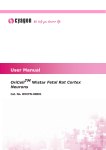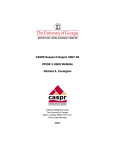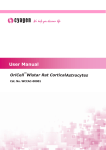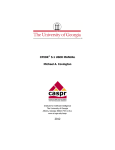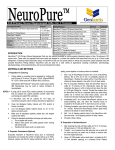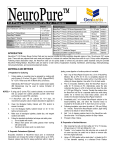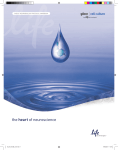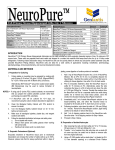Download User Manual - Cyagen Biosciences
Transcript
User Manual OriCellTMWistar Fetal Rat Hippocampus Neurons Cat. No. WHCFN-00001 Table of Contents Contents and Storage …………………………………………………………………………………… 3 Product Introduction ………………………………………………………………………………… 3 Product Applications ……………………………………………………………………………………… 4 Cyagen OriCellTM Wistar Fatal Rat Hippocampus Neurons source …………………………… 4 General Handling Principles ……………………………………………………………………………… 4 Preparing Growth Medium and Culture Vessels Poly-L-lysine/Laminin Coating of Tissue Culture Plate ………………………………………… 4 TM Culturing OriCell Wistar Fatal Rat Hippocampus Neurons Thawing and Establishing OriCell TM Wistar Fatal Rat Hippocampus Neurons…… 4 Appendix ……………………………………………………………………………………6 Related Products …………………………………………………………………………………………… 6 References ……………………………………………………………………………………………………… 6 Technical Support ……………………………………………………………… 6 CONTENTS AND STORAGE Product Name Wistar Fetal Rat Hippocampus Neurons Catalog No. WHCFN-00001 Amount per Vial 1×106 Cells Cryopreserved At Primary Passage Storage Condition Liquid Nitrogen CAUTION: Please handle this product as a potentially biohazardous material. This product contains Dimethyl Sulfoxide (DMSO), a hazardous material, in the freezing medium. PRODUCT INTRODUCTION Neurons, also known as nerve cells, connect to each other to form networks. They are the main components of the nervous system and are potent tools in studying function of the neural system. Cyagen OriCellTM Wistar Fetal Rat Hippocampus Neurons are derived from the Hippocampus of qualified Wistar rat embryos (18.5 dpc) and cryopreserved as primary cells. These cells express specific clusters of different proteins for neurons. They have been tested negative for bacteria, fungi and mycoplasma. Viability of Cyagen OriCellTM Wistar Fatal Rat Hippocampus Neurons Recovery Viability ≥ 50% Purity of Cyagen OriCellTM Wistar Fatal Rat Hippocampus Neurons MAP2 positive cells ≥ 70% β-tubulin III positive cells ≥ 70% GFAP positive cells ≤ 10% This product is intended for laboratory research use only. It is not intended for diagnostic, therapeutic, clinical, household, or any other applications. IMPI0052A2 WHCFN-00001 Page 3 of 6 PRODUCT APPLICATIONS OriCellTM Wistar Fetal Rat Hippocampus Neurons can be used in neurobiology studies and drug discovery in areas such as Parkinson’s Disease and Alzheimer’s Disease. GENERAL HANDLING PRINCIPLES Aseptic handling of the product is necessary throughout. POLY-L-LYSIN/LAMININ COATING OF TISSUE CULTURE PLATE 1. The day before plating cells for differentiation, prior to prepare the coated plates with PLL/laminin. 2. Dilute Poly-L-lysine stock Solution (1mg/mL) with water to yield 15μg/mLsolution. 3. Add enough of Poly-L-lysine Solution into the culture vessel to completely cover the base. 4. Swirl until Poly-L-lysine Solution coats the entire base of vessel. Sit for at least 30 minutes at room temperature. 5. Aspirate off all of the Poly-L-lysine Solution and rinse the vessel once with sterile water. Aspirate after each rinse. 6. Use sterile 1X PBS, dilute the Laminin stock Solution (1mg/mL) to a final concentration of 15μg /mL. 7. Add enough of Laminin Solution into the culture vessel to completely cover its base. Incubate overnight at 4°C, coated vessels can be stored in the Laminin Solution at 4°C for up to one week. 8. Just before use, aspirate the Laminin Solution in the coated vessels and wash the wells once with 1X PBS. Aspirate after rinse. THAWING AND ESTABLISHING OriCell HIPPOCAMPUS NEURONS TM WISTAR FETAL RAT Materials Required: OriCellTM Wistar Fetal Rat Hippocampus Neurons (Cat. No. WHCFN-00001) OriCellTM Neuron Growth Medium (Cat. No. GXXNR-90011) Thawing and Establishing Wistar Fetal Rat Hippocampus Neurons 1. Pre-warm the OriCellTM Wistar Fatal Rat Hippocampus Neuron Growth Medium to 37°C. 2. Remove the cryovial of OriCellTM Wistar Fatal Rat Hippocampus Neurons from liquid nitrogen. Quickly thaw the vial in a 37°C water bath until the last ice crystal IMPI0052A2 WHCFN-00001 Page 4 of 6 disappears. For optimal results, be sure to finish the thawing procedure within 3 minutes. Be careful not to submerge the entire vial. Maximum cell viability is dependent on the rapid and complete thawing of frozen cells. Note: Thawing the cells for longer than 3 minutes results in less than optimal results. 3. As soon as the cells are completely thawed, disinfect the outside of the vial with 70% v/v ethanol. 4. Use a pipette to transfer 1mL Neurons Growth Medium to the vial drop by drop in side a biosafety cabinet, mix by gently pipetting. Subsequently transfer this 2mL of cell suspension into the conical tube containing Neurons Growth Medium drop by drop. Be careful not to introduce any bubbles during the transfer process. 5. Rinse the vial with 1 mL of medium to reduce cell loss. Subsequently transfer this 1mL of cell suspension to the conical tube. 6. Gently mix the cell suspension by slowly pipetting up and down. Be careful not to introduce any bubbles. 7. Take a small sample of the cells from the cells suspension. Determine the viable cell density using vital staining assay with trypan blue. 8. Plate around 1×105 /cm2 viable cells in poly-L-lysine/Laminin coated plate. Gently rock the culture plate to evenly distribute the cells. Note: Do not centrifuge the cells as they are extremely fragile upon recovery. 9. Incubate the cells at 37°C in a 5% CO2 humidified incubator. 10. Six hours later, change half of the medium with fresh OriCellTM Neuron Growth Medium (pre-warmed to 37°C). Change half of the medium every three days, or change the entire medium every three days if there is any cell death. TM Fig. 1 OriCell IMPI0052A2 WHCFN-00001 Wistar Fetal Rat Hippocampus Neurons are established Page 5 of 6 APPENDIX Related products Product Catalog Number OriCellTM Wistar Fetal Rat Hippocampus Neurons WHCFN-00001 OriCellTM Wistar Fatal Rat Cortex Neurons WCCFN-00001 OriCellTM Neuron Growth Medium GXXNR-90011 References Greory J Brewer, and John R Torricelli. (2007) Isolation and culture of adult neurons and neurospheres. Nature 2: 1490-1498. CHENGSONG XIE, William R, Markesbery, and Mark A, Lovell. (2000) Survival of Hippocampal and Cortical Neurons in a Mixture of MEM and B27 Supplemented Neurobasal Medium. Free Radical Biology & Medicine 28: 665-672. Cyagen Biosciences reserves all rights on the technical documents of its OriCell TM cell culture products. No part of this document may be reproduced or adapted for other purposes without written permission from Cyagen Biosciences. IMPI0052A2 WHCFN-00001 Page 6 of 6






